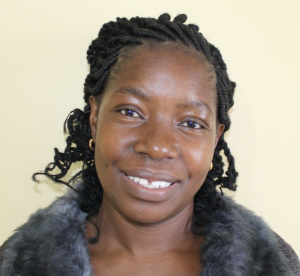The Makale Community has 240 residents, all of whom direly need accessible, clean water. Their current water source, Wilson Muranda Spring, is in disrepair and causes more problems than it solves.

Field Officer Christine Masinde described their current water source. "The terrain that leads to the spring is on a steep slope, which can easily cause people to lose their footing and fall. This could lead to serious injuries, especially to children and the elderly, who are more vulnerable to falls. During heavy rainfall, the path is eroded, making it more dangerous. There is overcrowding at the spring, which leads to time wastage and conflict over access to the spring water."

16-year-old Jonathon has much to say about how the water crisis affects his life.
He shared, "Long queues at the waterpoint lead to long wait times, which is frustrating to my peers and me, who are students. Our waterpoint has three [discharge] pipes, yet the cumulative discharge is just enough for one pipe! This problem should be resolved in order to reduce time spent [in] the spring."

Jonathan.
The long lines that Jonathon mentioned cause unrest within the community. While waiting, everyone sacrifices the time needed for other essential tasks, putting people on edge and disrupting the unity crucial for the community to thrive.
"When the waterpoint is overcrowded, there is always tension, which leads to quarrels and sometimes fights since everyone wants to be the first one to fetch water. Children are the most affected since adults do not allow us to fetch water before they do," he continued.
"There was a time I had fetched water, then a lady who is about the age of my mother came and poured my water into her container without requesting me. When I protested, I was rebuked by other water users. I was angry, but there was nothing I could do since, in our community, the elderly are considered to be always right."

Intense emotions make an already difficult situation impossible. Jonathon experiences this firsthand every day. It impacts his time in line at the spring and, more importantly, negatively affects his education.
"Fetching water from our current water source is cumbersome and time-consuming, which [I] would rather be used for studying or doing my homework. Fetching water is a daily routine for me, especially in the mornings before going to school and in the evenings after school. This impacts my education negatively because of minimal concentration in class because of fatigue after carrying water."
Field Officer Christine Masinde was impacted greatly by what she witnessed when interviewing people at the waterpoint. "The saddest moment I experienced when I visited this community was watching a young boy, around three years old, fetch water from their waterpoint while stepping in dirty water. A few minutes later, he drank water directly from his container without worrying about the contamination. We can only hope that this waterpoint will be protected soon so as to secure the future of this boy and other children, too."
The Makale community's children and adults need safe access to clean water. Protecting their spring will restore their health and well-being and hopefully bring them peace.
Jonathon shared his future plans, which are only possible with clean water.
"My future plan is to work hard in school and attain good grades, which will secure me a position to join university," concluded Jonathon.
Steps Toward a Solution
Our technical experts worked with the local community to identify the most effective solution to their water crisis. They decided to safeguard the existing flowing spring.
Spring Protection
Springs are natural water sources that originate from deep underground. As water travels through various layers of the earth, it undergoes a natural filtration process, making it cleaner and safer to drink. To protect these spring sources from contamination, we construct a waterproof cement structure around layers of clay, stone, and soil. This design channels the spring water through a discharge pipe, facilitating easier, faster, and cleaner water collection.
Chlorine Dispenser
As an extra measure towards water quality safety, uniquely engineered chlorine dispensers are installed at all of our spring protection projects so community members can treat their water with pre-measured doses of chlorine. The chlorine treats any residual contamination and stays active for two to three days, ensuring water stays safe to use even when stored at home. Chlorine delivery and maintenance of the dispensers are part of our ongoing community support.
Community Education & Ownership
Hygiene and sanitation training are integral to our water projects. Training is tailored to each community's specific needs and includes key topics such as proper water handling, improved hygiene practices, disease transmission prevention, and care of the new water point. Safe water and improved hygiene habits foster a healthier future for everyone in the community. Encouraged and supported by the guidance of our team, a water user committee representative of the community's diverse members assumes responsibility for maintaining the water point, often gathering fees to ensure its upkeep.

 Protected Spring
Protected Spring
 Rehabilitation Project
Rehabilitation Project


















